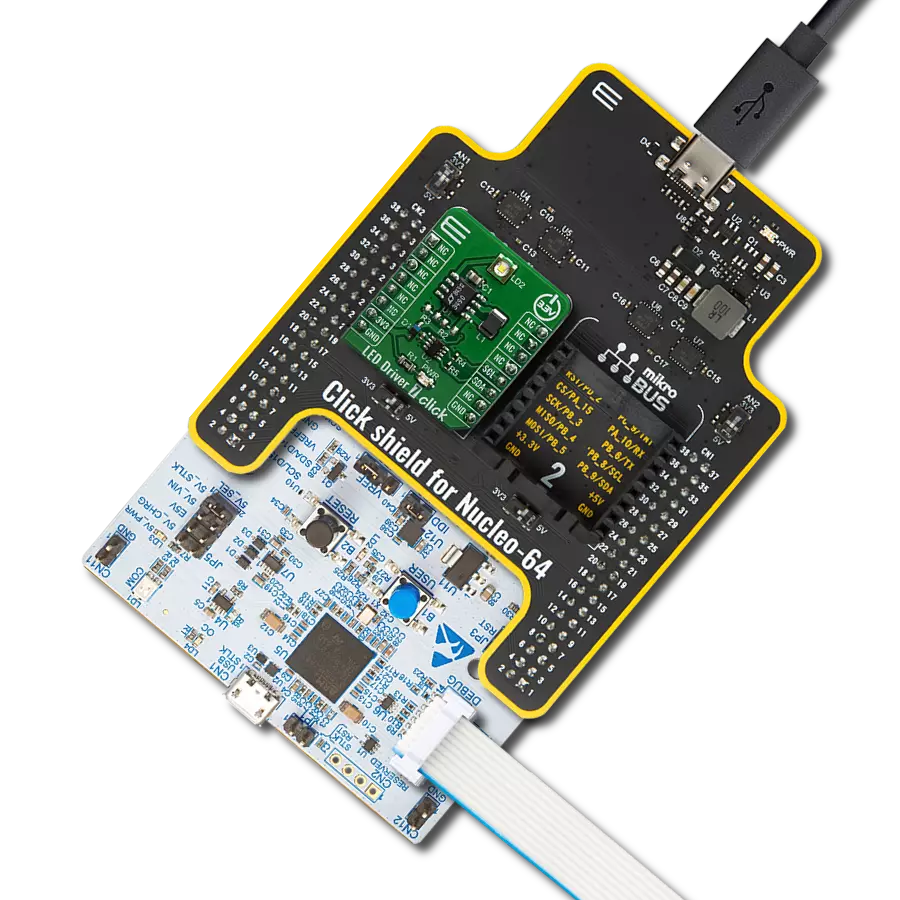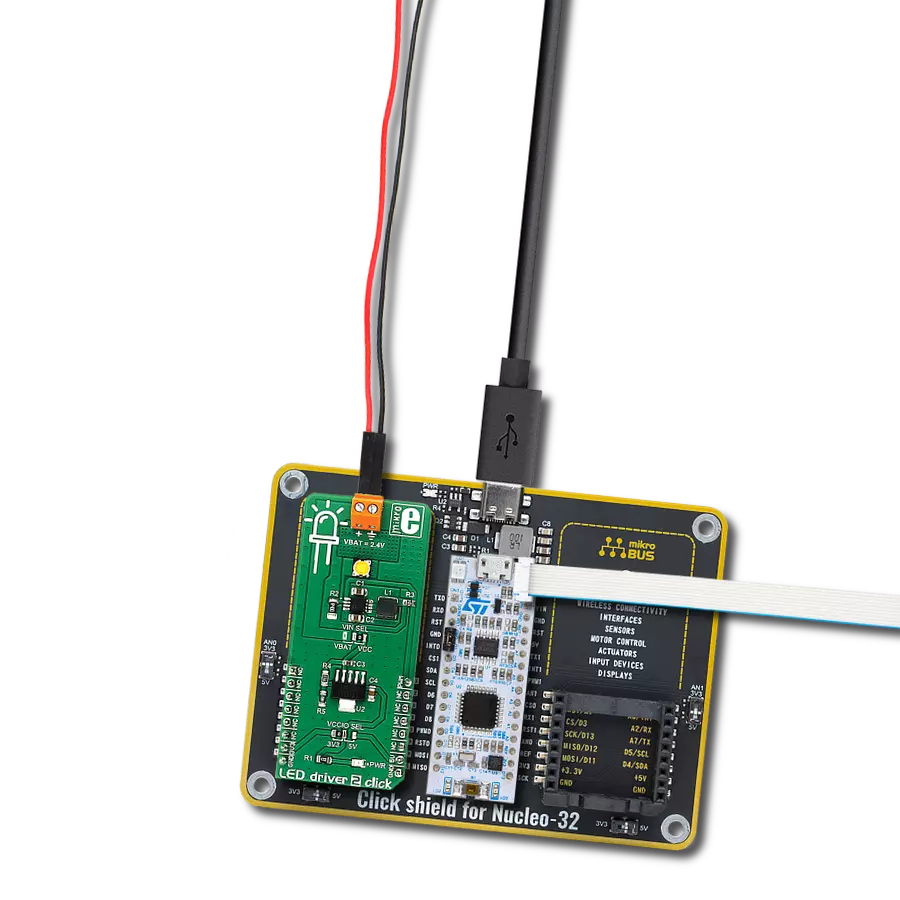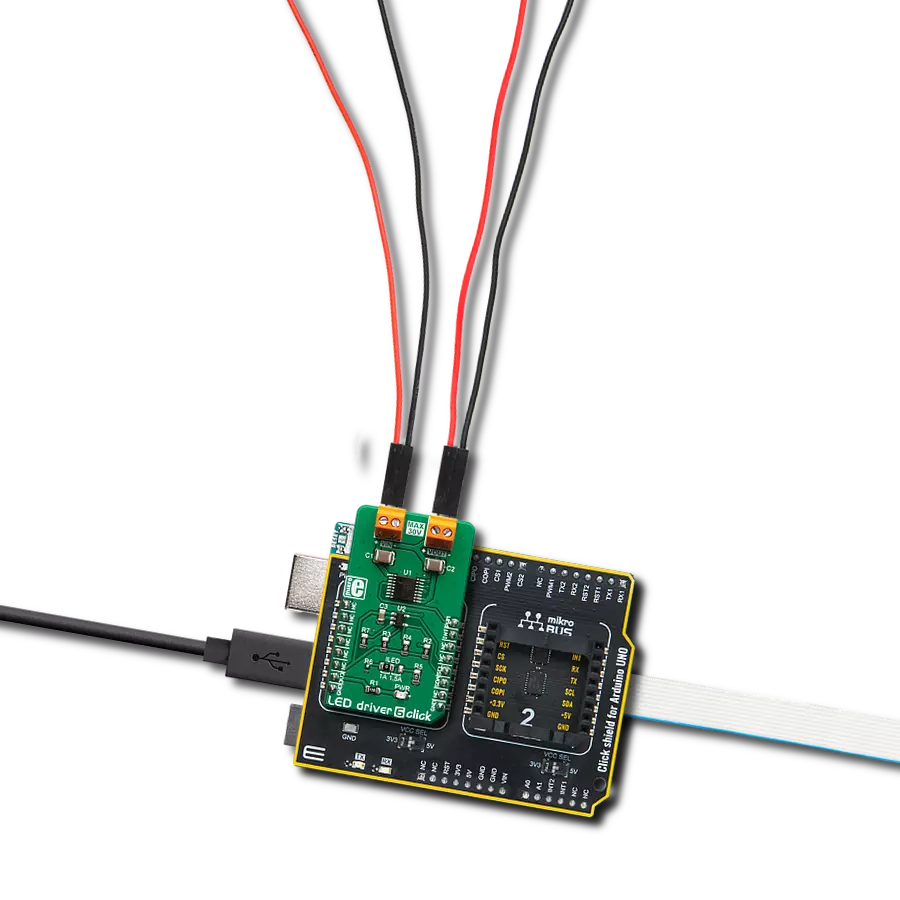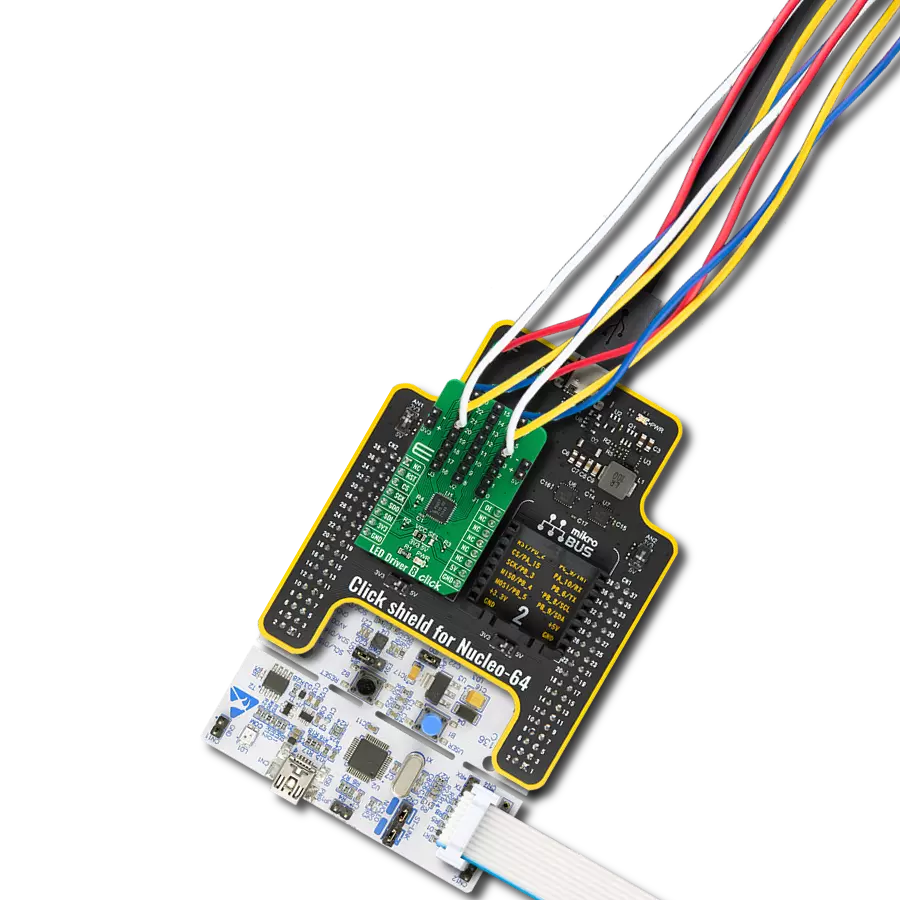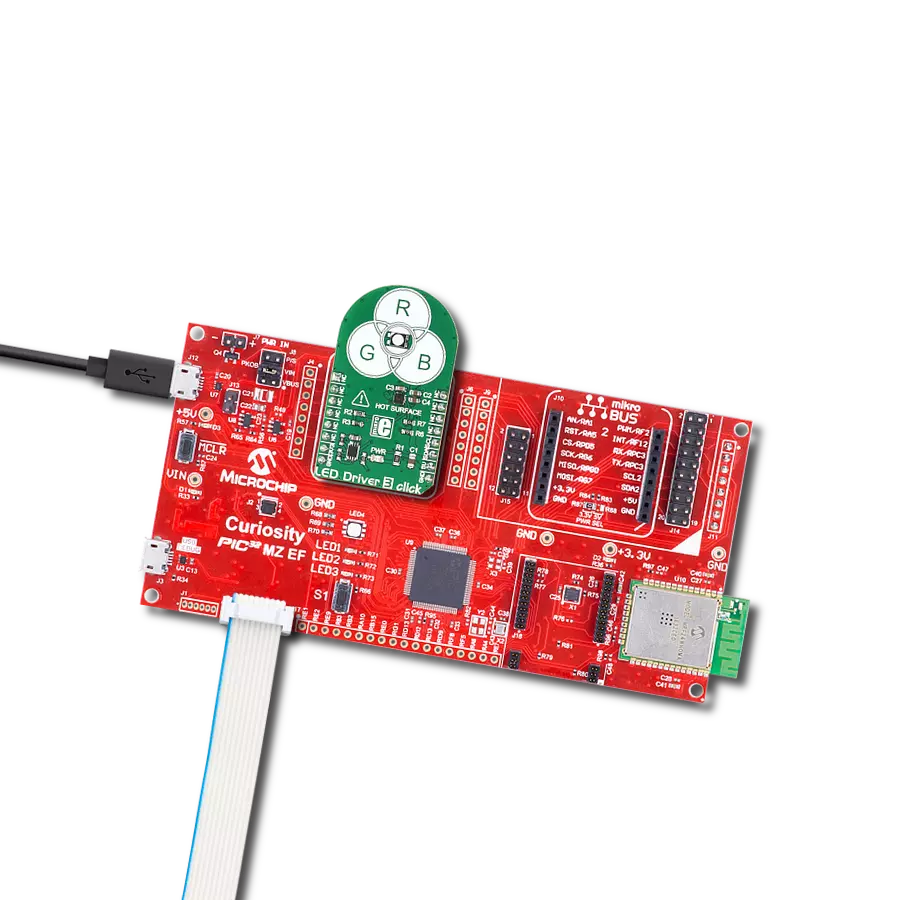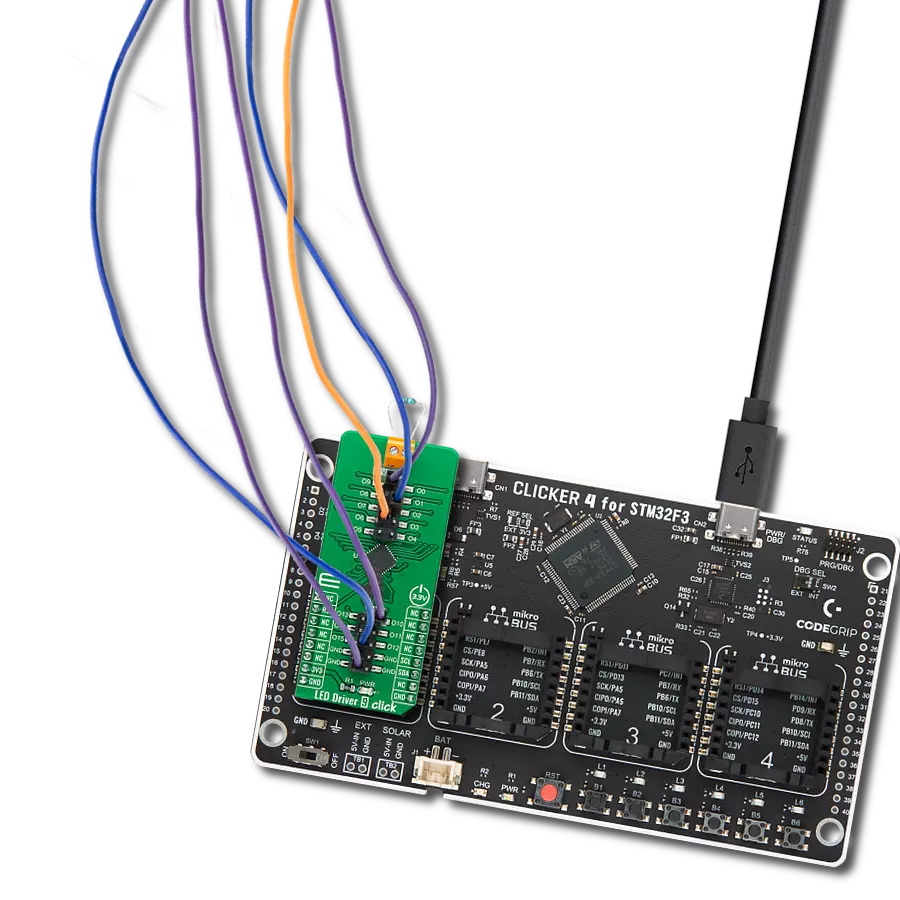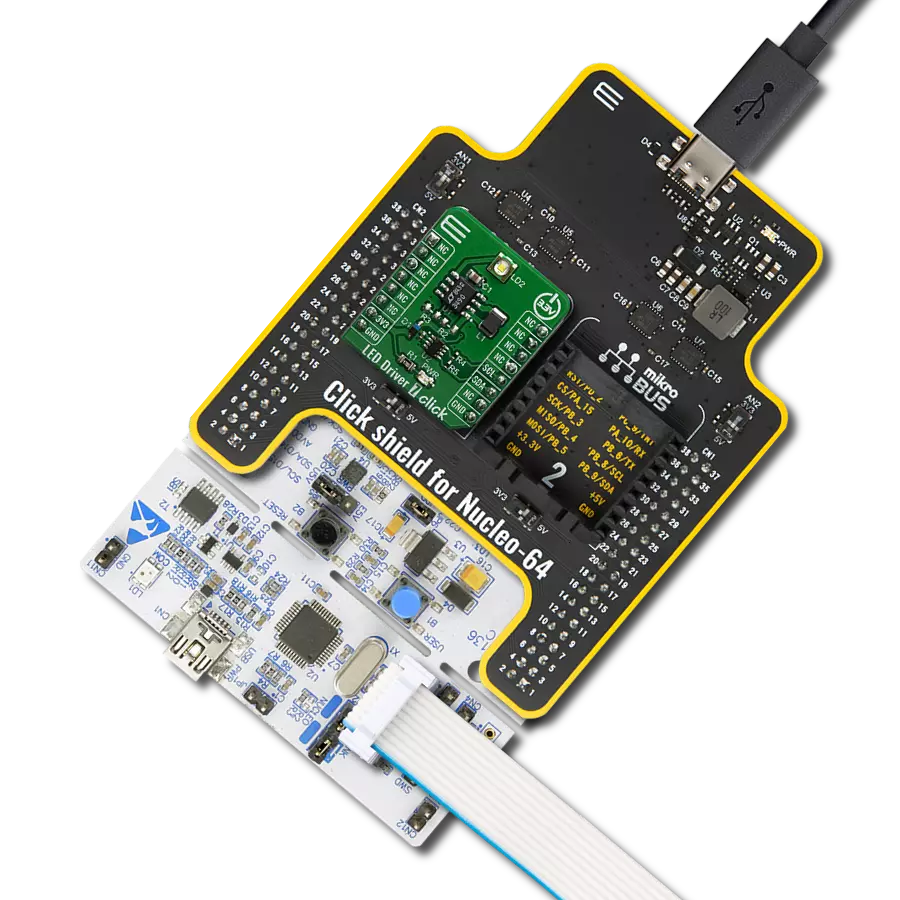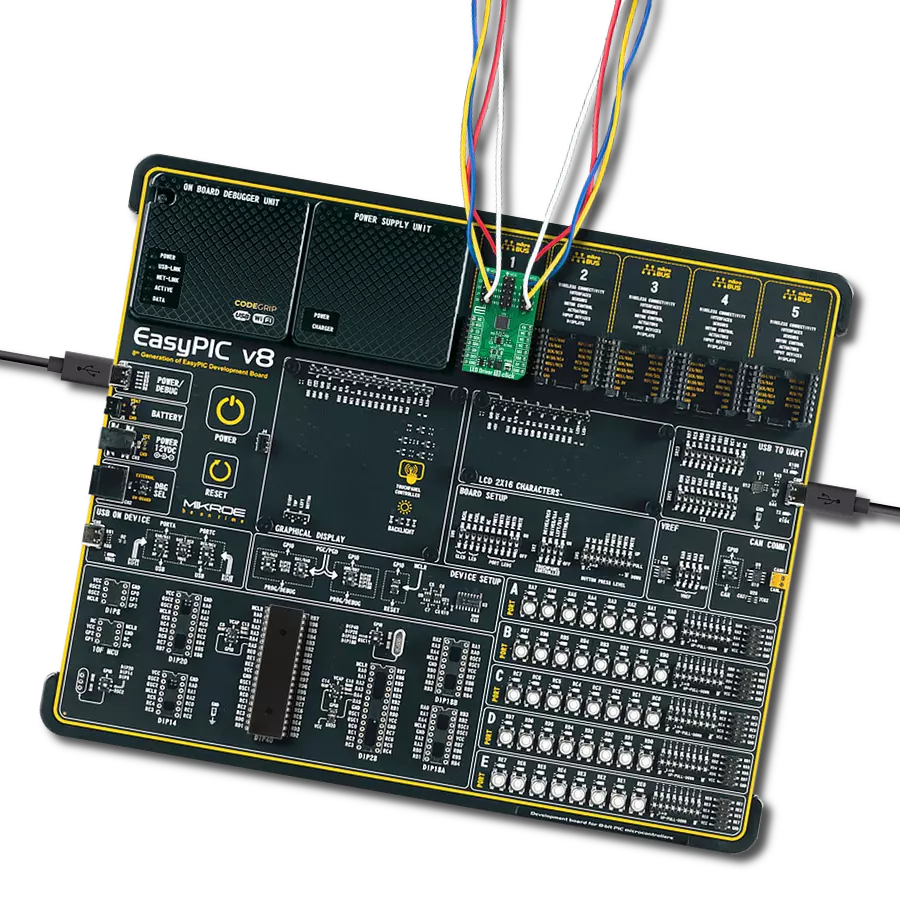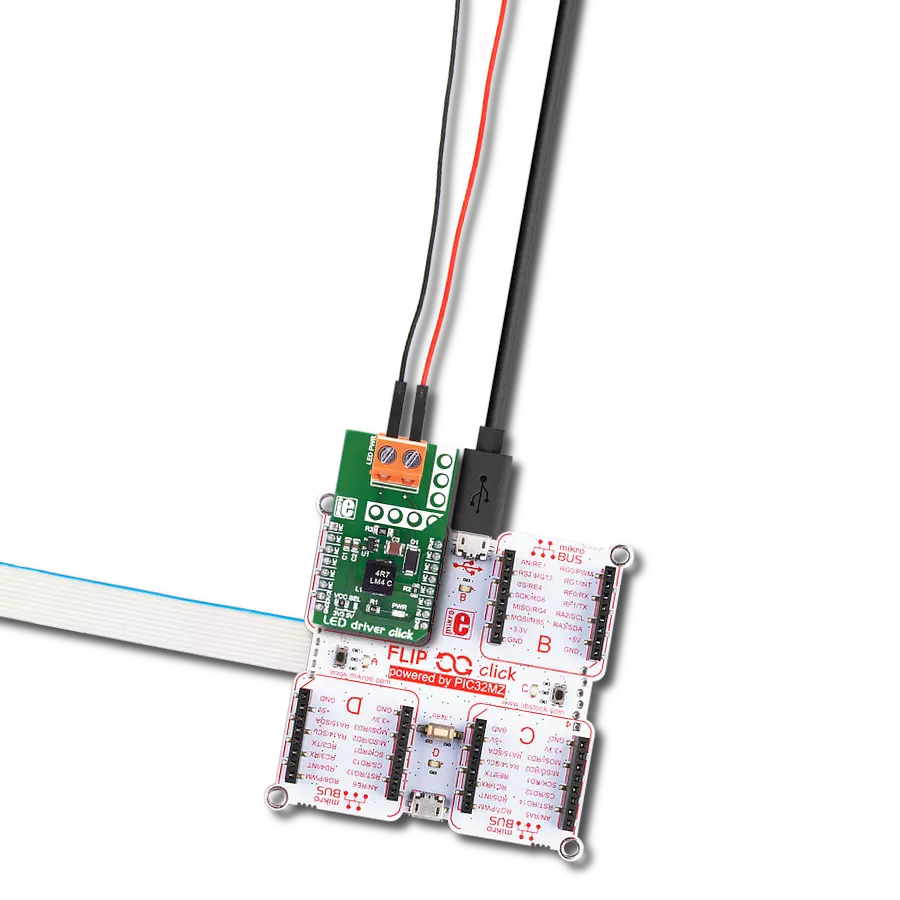Our LED driver is engineered to simplify the integration of LED functionality into your circuit designs, reducing development time and costs
A
A
Hardware Overview
How does it work?
LED Driver 8 Click is based on the PCA9957, a daisy-chain SPI-compatible 4-wire serial bus controlled 24-channel constant current LED driver optimized for dimming and blinking 32 mA RGBA LEDs from NXP Semiconductors. The PCA9957 has 24 internal 8-bit DACs with an operating frequency of 31.25 kHz and a duty cycle from 0% to 100% used to adjust brightness levels for each LED current source. Each LED output is programmable and can be turned off, on (with no PWM control), set at its individual PWM controller value, or both individual and group PWM controller values. Its output peak current is adjustable with an 8-bit linear DAC from 125 μA to 31.875 mA because of the R4 resistor of 2kΩ connected to the REXT pin. Gradation control for all current sources is achieved through a serial interface and
allows the user to ramp current automatically without help from the MCU. It has two operation modes for each group: Single-Shot Mode (output pattern once) and Continuous Mode (output pattern repeat). Each channel can be set to either Gradation Mode or Normal Mode and assigned to any of the six gradation control groups. These groups have four independent registers to control ramp-up and ramp-down rate, step time, hold ON/OFF time, and final hold ON output current. The LED Driver 8 Click communicates with MCU through a daisy-chain SPI-compatible 4-wire serial interface with a clock frequency of up to 10 MHz. The input labeled as OE routed to the PWM pin on the mikroBUS™ blinks all the LED outputs and can be used to externally PWM the outputs, which is useful when multiple devices need to be
dimmed or blinked together without software control. The PCA9957 also has a short load and overtemperature detection circuitry, a thermal shutdown feature that protects the device when the internal junction temperature exceeds the factory-defined limit, and a Reset function routed to the RST pin on the mikroBUS™ which is activated by sending an active low input on this pin with a minimum pulse width of 2.5μs. This Click board™ can operate with either 3.3V or 5V logic voltage levels selected via the VCC SEL jumper. This way, both 3.3V and 5V capable MCUs can use the communication lines properly. Also, this Click board™ comes equipped with a library containing easy-to-use functions and an example code that can be used as a reference for further development.
Features overview
Development board
Clicker 2 for Kinetis is a compact starter development board that brings the flexibility of add-on Click boards™ to your favorite microcontroller, making it a perfect starter kit for implementing your ideas. It comes with an onboard 32-bit ARM Cortex-M4F microcontroller, the MK64FN1M0VDC12 from NXP Semiconductors, two mikroBUS™ sockets for Click board™ connectivity, a USB connector, LED indicators, buttons, a JTAG programmer connector, and two 26-pin headers for interfacing with external electronics. Its compact design with clear and easily recognizable silkscreen markings allows you to build gadgets with unique functionalities and
features quickly. Each part of the Clicker 2 for Kinetis development kit contains the components necessary for the most efficient operation of the same board. In addition to the possibility of choosing the Clicker 2 for Kinetis programming method, using a USB HID mikroBootloader or an external mikroProg connector for Kinetis programmer, the Clicker 2 board also includes a clean and regulated power supply module for the development kit. It provides two ways of board-powering; through the USB Micro-B cable, where onboard voltage regulators provide the appropriate voltage levels to each component on the board, or
using a Li-Polymer battery via an onboard battery connector. All communication methods that mikroBUS™ itself supports are on this board, including the well-established mikroBUS™ socket, reset button, and several user-configurable buttons and LED indicators. Clicker 2 for Kinetis is an integral part of the Mikroe ecosystem, allowing you to create a new application in minutes. Natively supported by Mikroe software tools, it covers many aspects of prototyping thanks to a considerable number of different Click boards™ (over a thousand boards), the number of which is growing every day.
Microcontroller Overview
MCU Card / MCU
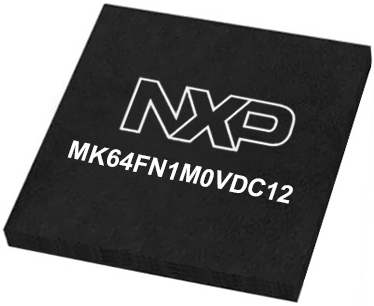
Architecture
ARM Cortex-M4
MCU Memory (KB)
1024
Silicon Vendor
NXP
Pin count
121
RAM (Bytes)
262144
Used MCU Pins
mikroBUS™ mapper
Take a closer look
Click board™ Schematic

Step by step
Project assembly
Software Support
Library Description
This library contains API for LED Driver 8 Click driver.
Key functions:
leddriver8_set_brightness- Function for set brightnessleddriver8_set_output_gain- Function for set output gainleddriver8_set_mode_register- Function for set mode registers
Open Source
Code example
The complete application code and a ready-to-use project are available through the NECTO Studio Package Manager for direct installation in the NECTO Studio. The application code can also be found on the MIKROE GitHub account.
/*!
* \file
* \brief LedDriver8 Click example
*
* # Description
* This example demonstrates the use of LED Driver 8 Click board.
*
* The demo application is composed of two sections :
*
* ## Application Init
* Initializes the driver and configures the Click board.
*
* ## Application Task
* Increases the LEDs brightness then toggles all LEDs with a one-second delay.
* Each step will be logged on the USB UART where you can track the program flow.
*
* \author MikroE Team
*
*/
// ------------------------------------------------------------------- INCLUDES
#include "board.h"
#include "log.h"
#include "leddriver8.h"
// ------------------------------------------------------------------ VARIABLES
static leddriver8_t leddriver8;
static log_t logger;
// ------------------------------------------------------ APPLICATION FUNCTIONS
void application_init ( void )
{
log_cfg_t log_cfg;
leddriver8_cfg_t cfg;
/**
* Logger initialization.
* Default baud rate: 115200
* Default log level: LOG_LEVEL_DEBUG
* @note If USB_UART_RX and USB_UART_TX
* are defined as HAL_PIN_NC, you will
* need to define them manually for log to work.
* See @b LOG_MAP_USB_UART macro definition for detailed explanation.
*/
LOG_MAP_USB_UART( log_cfg );
log_init( &logger, &log_cfg );
log_info( &logger, "---- Application Init ----" );
// Click initialization.
leddriver8_cfg_setup( &cfg );
LEDDRIVER8_MAP_MIKROBUS( cfg, MIKROBUS_1 );
leddriver8_init( &leddriver8, &cfg );
leddriver8_reset( &leddriver8 );
Delay_ms ( 500 );
leddriver8_output_enable_pin( &leddriver8, LEDDRIVER8_ENABLE_LED_OUTPUTS );
leddriver8_set_output_gain( &leddriver8, LEDDRIVER8_OUTPUT_GAIN_ALL_LED, LEDDRIVER8_FULL_OUTPUT_CURRENT_GAIN );
leddriver8_set_mode_register( &leddriver8, LEDDRIVER8_MODE1_NORMAL_MODE, LEDDRIVER8_MODE2_DMBLNK_DIMMING |
LEDDRIVER8_MODE2_CLRERR_ALL | LEDDRIVER8_MODE2_EXP_DISABLE );
log_info( &logger, "---- Application Task ----" );
Delay_ms ( 500 );
}
void application_task ( void )
{
uint16_t cnt;
log_printf( &logger, "Increasing LEDs brightness...\r\n" );
log_printf( &logger, "----------------------------\r\n" );
for ( cnt = LEDDRIVER8_MIN_BRIGHTNESS; cnt <= LEDDRIVER8_MAX_BRIGHTNESS; cnt++ )
{
leddriver8_set_brightness( &leddriver8, LEDDRIVER8_BRIGHTNESS_ALL_LED, cnt );
Delay_ms ( 20 );
}
log_printf( &logger, "Toggling all LEDs...\r\n" );
log_printf( &logger, "----------------------------\r\n" );
for ( cnt = 0; cnt < 5; cnt++ )
{
leddriver8_set_brightness( &leddriver8, LEDDRIVER8_BRIGHTNESS_ALL_LED, LEDDRIVER8_MAX_BRIGHTNESS );
Delay_ms ( 1000 );
leddriver8_set_brightness( &leddriver8, LEDDRIVER8_BRIGHTNESS_ALL_LED, LEDDRIVER8_MIN_BRIGHTNESS );
Delay_ms ( 1000 );
}
}
int main ( void )
{
/* Do not remove this line or clock might not be set correctly. */
#ifdef PREINIT_SUPPORTED
preinit();
#endif
application_init( );
for ( ; ; )
{
application_task( );
}
return 0;
}
// ------------------------------------------------------------------------ END
Additional Support
Resources
Category:LED Drivers


















